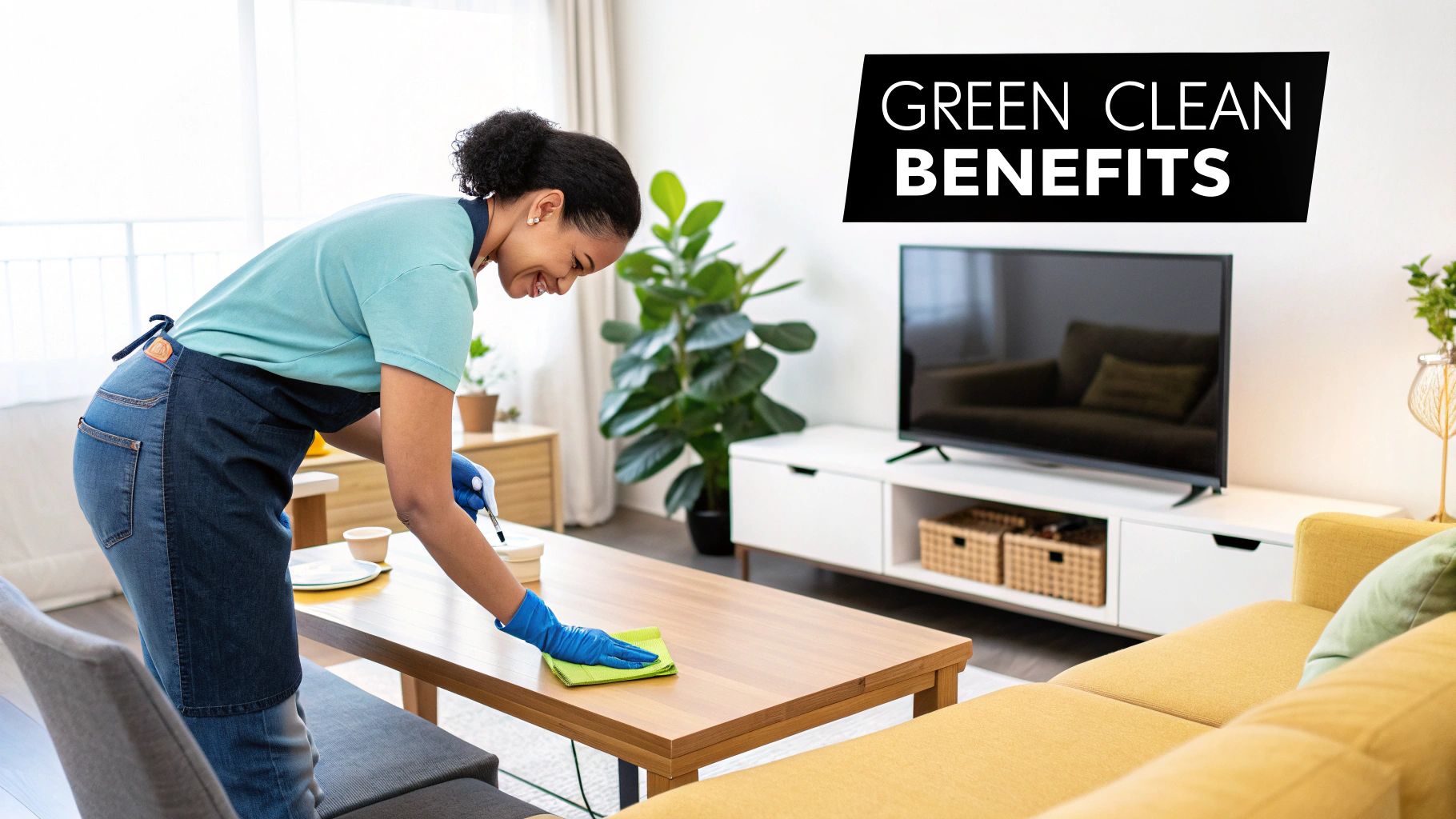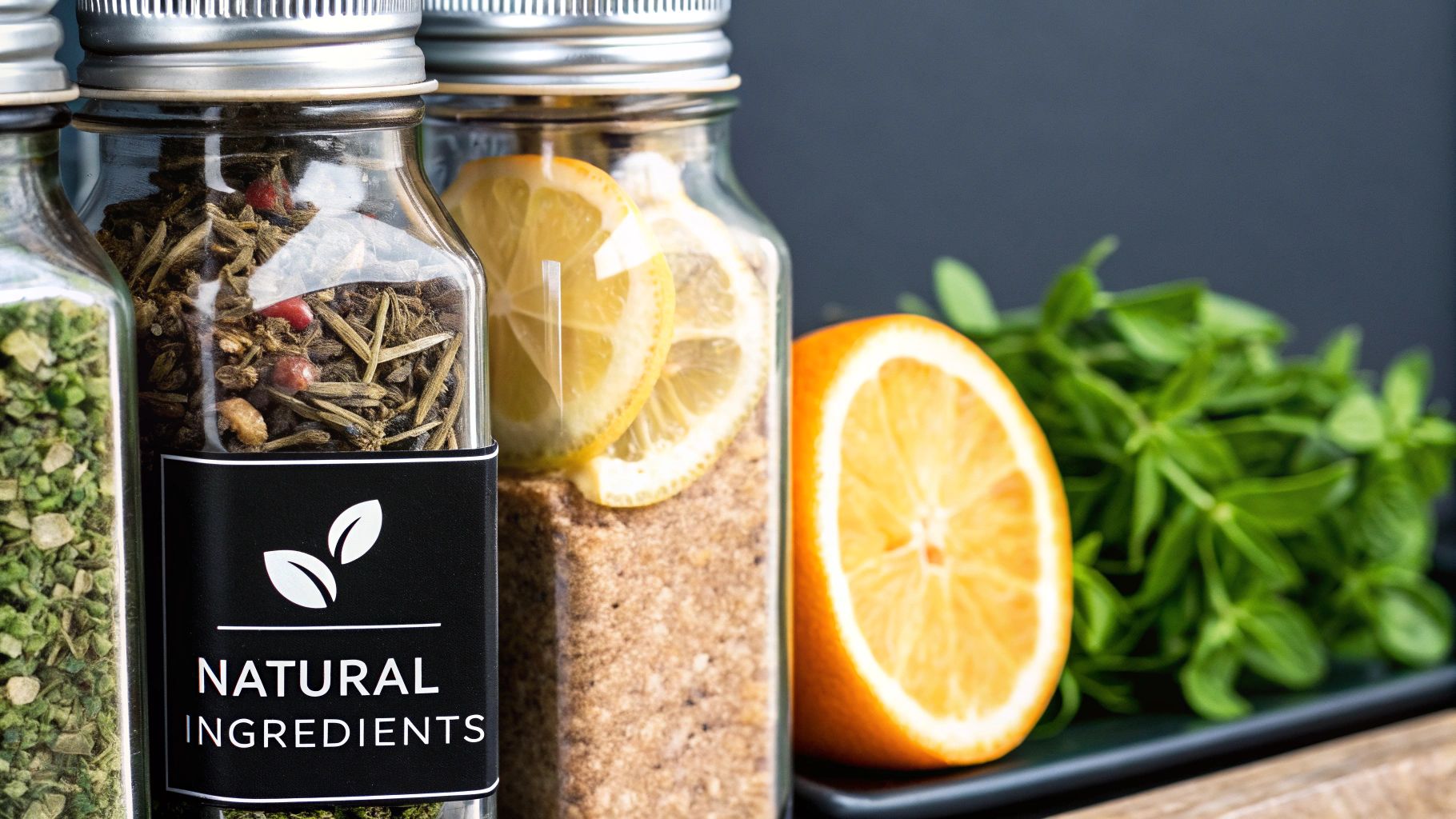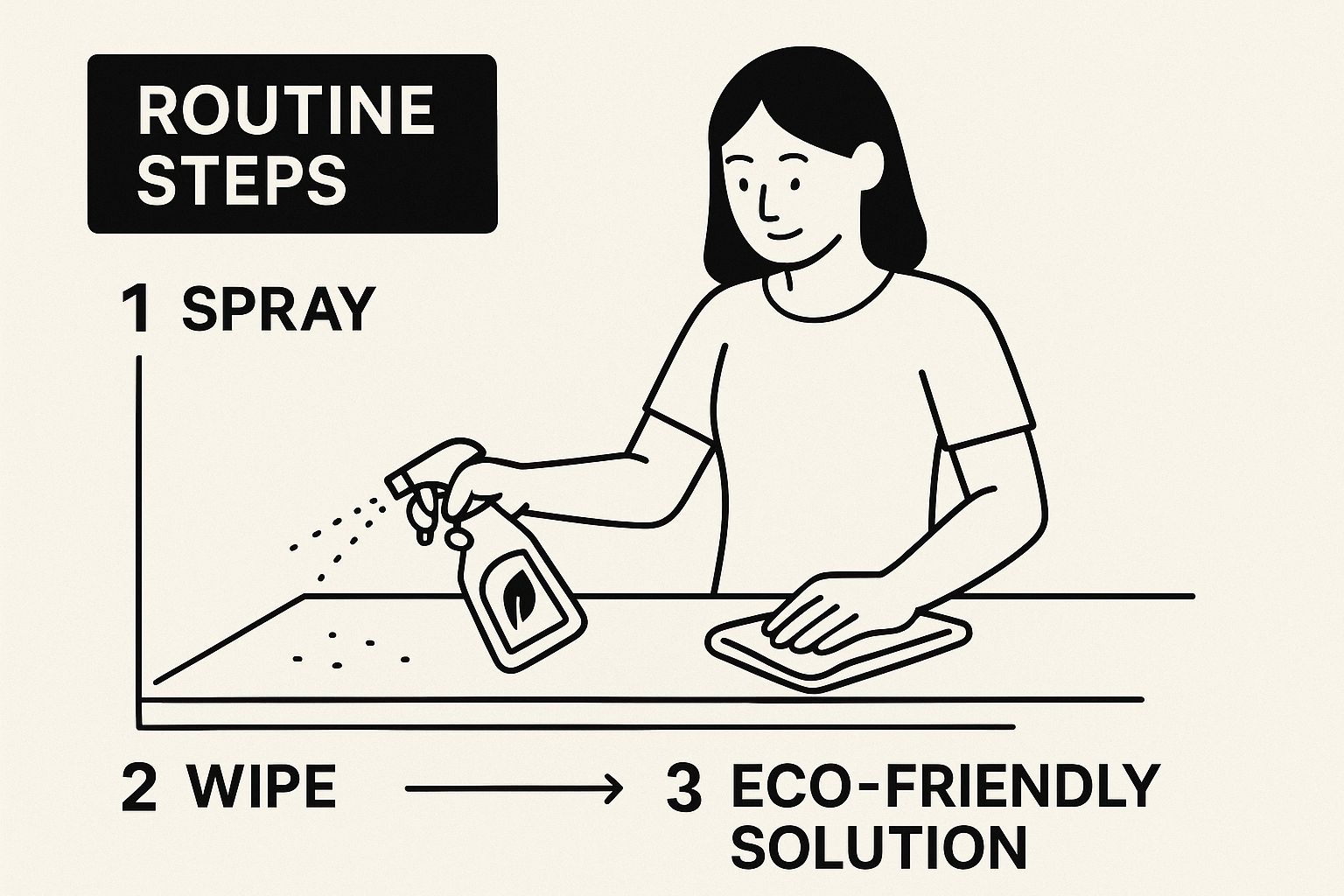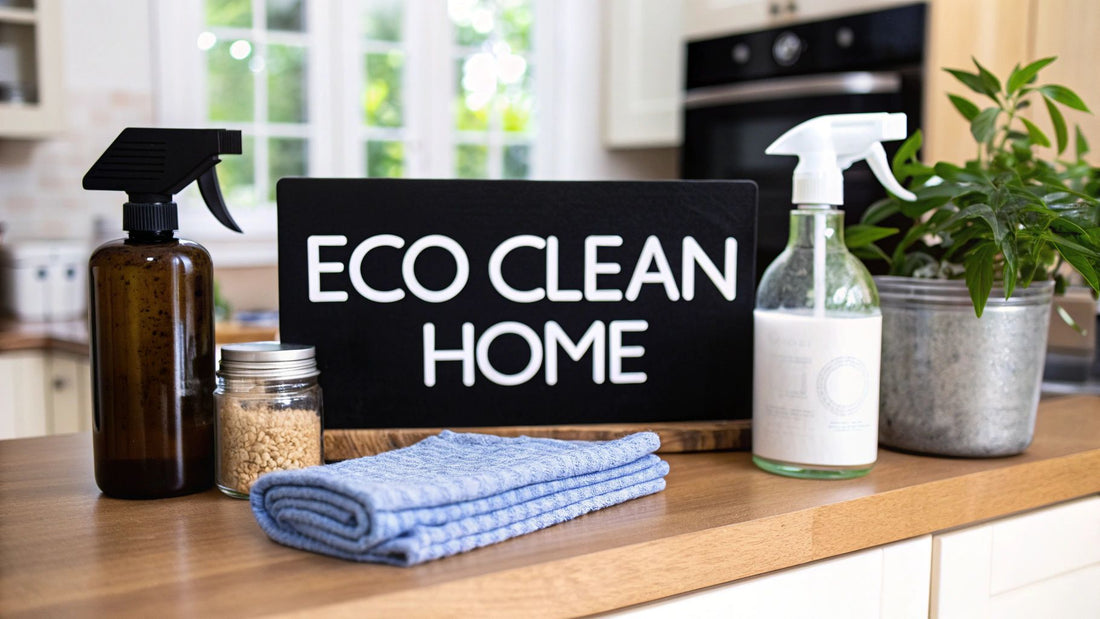Eco-friendly house cleaning is all about using cleaning methods and products that are safe for your family, your pets, and the planet. It means swapping out harsh chemicals for things like plant-derived ingredients, ditching single-use items for reusable tools, and building sustainable habits that create a genuinely healthier home.
Why Green Cleaning Is More Than Just a Trend

The move toward eco-friendly house cleaning isn't just a fleeting fad; it's a real shift in how we think about our homes. More and more, homeowners are realizing that the cleaning choices they make have a huge impact, not just on their family’s health but on the environment, too. This isn't about jumping on a bandwagon—it's a responsible, smart lifestyle choice with benefits you can actually see and feel.
One of the biggest wins is a dramatic improvement in your indoor air quality. Traditional cleaners are notorious for releasing volatile organic compounds (VOCs), which can hang in the air for hours and contribute to everything from respiratory issues and headaches to skin irritation. When you opt for products made with natural ingredients, you’re creating a safer breathing space for everyone, especially kids and pets who are much more sensitive to those airborne chemicals.
A Healthier Home and Planet
The positive ripple effects of green cleaning go way beyond your front door. When you pour conventional cleaners down the drain, their non-biodegradable chemicals often find their way into local waterways, harming aquatic life and messing with fragile ecosystems. Eco-friendly alternatives, on the other hand, are made to break down without causing harm.
This change in mindset is shaking up the market. The global demand for eco-friendly cleaning products was valued at around $31 billion in 2023 and is expected to more than double to $71 billion by 2032. That kind of explosive growth tells you everything you need to know: consumers everywhere are prioritizing health and sustainability. You can explore more data on this market shift to see just how big this movement has become.
Making the switch is about taking back control over what you bring into your home. It’s a proactive step toward minimizing chemical exposure and fostering a non-toxic living environment for your loved ones.
The Surprising Financial Perks
Besides all the health and environmental upsides, an eco-friendly house cleaning routine can actually save you money. It turns out that some of the most powerful natural cleaners are probably already sitting in your pantry.
- White Vinegar: A fantastic disinfectant and degreaser.
- Baking Soda: A gentle abrasive that’s perfect for scrubbing jobs.
- Castile Soap: A super versatile, plant-based soap that works on tons of different surfaces.
By leaning on these multi-purpose staples and a few simple DIY recipes, you can drastically cut back on what you spend on those specialized, single-use commercial products.
Assembling Your Natural Cleaning Toolkit

You really don't need a cabinet overflowing with harsh, specialized chemicals to get a truly clean home. In fact, a powerful and effective eco-friendly house cleaning routine starts with just a handful of simple, versatile ingredients. Building this toolkit is your first real step toward a healthier, more sustainable home.
The best part about this approach is its beautiful simplicity. When you focus on a few core items, you slash your chemical exposure and waste, and you end up saving money, too. Many of these all-stars, like distilled white vinegar and baking soda, are probably already in your pantry.
The Essential Ingredients
These are the non-toxic powerhouses that will become the foundation of your entire cleaning arsenal. You can mix and match them to tackle nearly any mess in your home, from greasy stovetops to smudged windows.
- Distilled White Vinegar: Its acidity makes it a brilliant natural disinfectant and degreaser. It’s perfect for cutting through grime on countertops, in sinks, and on glass.
- Baking Soda: This is your gentle-but-mighty scrubber. Its mild abrasive quality is ideal for tackling soap scum in the bathroom, baked-on food in the kitchen, and deodorizing carpets without scratching surfaces.
- Castile Soap: A true multi-tasker, this vegetable-based soap is gentle enough for most surfaces yet effective enough to cut through dirt. I use it for everything from mopping floors to washing dishes.
- Lemon Juice: A natural bleach alternative and degreaser, lemon juice leaves behind a fresh, clean scent. It's great for polishing fixtures and removing stains.
This shift toward simpler, safer ingredients isn't just a niche trend; it's part of a massive global movement. The household green cleaning products market, valued at around $5.49 billion in 2024, is projected to surge to over $8.5 billion by 2030. This growth shows a huge consumer demand for ingredient transparency and products that are safer for families and the planet. You can explore the full research on this growing market to see the trends driving this change.
Here’s a quick-reference guide to the most versatile ingredients for your toolkit and what they do best.
Your Essential Eco-Friendly Cleaning Ingredients
| Ingredient | Primary Use | Best For |
|---|---|---|
| Distilled White Vinegar | Disinfecting, Degreasing | Countertops, glass, sinks, descaling |
| Baking Soda | Deodorizing, Gentle Scrubbing | Soap scum, baked-on food, carpets |
| Castile Soap | All-Purpose Cleaning | Mopping floors, washing dishes, surfaces |
| Lemon Juice | Bleaching, Degreasing | Polishing fixtures, stain removal, freshening |
With just these few staples, you're equipped to handle the vast majority of cleaning tasks around your home.
The Right Tools for the Job
Your ingredients are only half the equation. Having the right tools makes all the difference and helps minimize waste. Investing in reusable, durable items is a key part of any eco-friendly house cleaning strategy.
Think of these tools as long-term investments. Instead of buying disposable wipes and plastic sponges you'll just throw away, you're building a sustainable system that performs better and lasts for years.
A great place to start is by replacing disposables with these durable alternatives:
- Glass Spray Bottles: They are perfect for your DIY cleaners. Unlike plastic, glass doesn't leach chemicals into your mixtures and can be reused endlessly.
- Microfiber Cloths: These cloths are incredible at trapping dust and dirt, often requiring only water to clean surfaces effectively. They completely replace paper towels and can be washed and reused hundreds of times.
- Sturdy Scrub Brushes: Look for brushes with natural, compostable bristles (like coconut or tampico) and wooden handles. They’re tough on grime but gentle on the planet.
If you're looking for more ideas on what to stock your cleaning caddy with, you can also check out our guide on 13 cleaning tools people absolutely rave about for some professional-approved suggestions. By pairing these essential ingredients with the right tools, you'll be fully equipped to handle any cleaning task that comes your way—naturally and effectively.
Simple DIY Recipes for Every Surface
Alright, now that you've got your eco-friendly toolkit ready, it's time for the fun part: putting those simple ingredients to work. This is where green cleaning gets really satisfying. Forget about complicated formulas or confusing instructions—these are the tried-and-true recipes I use all the time, and you can mix them up in minutes with stuff you probably already have.
We're going to break down practical, effective solutions for the most common cleaning jobs around your home. For each recipe, I'll give you clear mixing directions, some personal tips I've picked up for getting the best results, and a heads-up on which surfaces need a little extra care. It’s all about taking the mystery out of homemade cleaners so you can tackle messes with confidence.
This image shows just how simple it is to weave these recipes into your daily routine with a quick spray-and-wipe.

As you can see, a quick spritz and a wipe with a microfiber cloth is often all you need for daily upkeep. That's what makes these recipes so perfect for busy households.
The Go-To All-Purpose Cleaner
Every home needs a reliable, multi-surface spray for daily wipe-downs of countertops, tables, and high-touch spots like light switches. This is my absolute favorite because it’s both effective and ridiculously easy to make.
Mixing It Up:
- Grab a 16-ounce glass spray bottle.
- Fill it halfway with distilled white vinegar.
- Top it off with an equal amount of distilled water.
- Add 10-15 drops of essential oil for a nice scent (lemon or tea tree oil are great choices).
- Give it a gentle shake before each use to mix everything together.
A Quick Word of Caution: Vinegar is acidic. While it’s fantastic for most surfaces, you should never use this spray on natural stone like marble, granite, or soapstone. It can cause etching and dull the finish over time.
Heavy-Duty Bathroom Scrub
Soap scum and tub grime can be a real pain, but you don’t need harsh chemicals to win the battle. This simple paste uses the gentle scrubbing power of baking soda to lift stubborn buildup without scratching your fixtures.
Creating the Paste:
- In a small bowl, mix about a half-cup of baking soda with just enough liquid castile soap to form a thick, frosting-like paste.
- For some extra disinfecting muscle, add 5-10 drops of tea tree essential oil.
- Apply the paste directly to the tub, shower walls, or sink using a non-scratch sponge.
- Let it sit for about 10-15 minutes to work its magic on the grime, then scrub in a circular motion and rinse it all away. It works wonders on grout lines, too!
Streak-Free Glass and Mirror Cleaner
Ditching commercial window cleaners is one of the easiest and most rewarding swaps you can make. This two-ingredient formula leaves glass and mirrors sparkling clean without that ammonia smell or annoying streaky residue.
The Simple Formula:
- Combine equal parts distilled white vinegar and distilled water in a spray bottle.
- Spray it right onto the glass surface.
- Wipe clean with a dry microfiber cloth, not a paper towel. Trust me, the microfiber is the secret to a lint-free, streak-free shine.
For really grimy windows, like on the outside of your house, I always wipe them down first with a damp cloth to get rid of the heavy dirt layer. This stops you from just smearing mud around with the cleaning spray.
Gentle Wood Polish and Conditioner
Wood furniture needs moisture to stay looking its best, but a lot of commercial polishes contain silicones and petroleum distillates that just build up on the surface. This natural alternative gently cleans, conditions, and protects wood instead.
- Ingredients: Mix ¼ cup of olive oil with 2 tablespoons of distilled white vinegar and 10 drops of lemon essential oil in a small jar.
- Application: Dab a small amount onto a soft, clean cloth and rub it into the wood, always going with the grain.
- Finishing Touch: Use a separate clean cloth to buff the surface to a beautiful, subtle sheen.
This polish is perfect for sealed wood furniture, but you’ll want to avoid it on unfinished or waxed wood. It's always a good idea to test it on a small, hidden spot first to make sure you love the result.
Your Room-By-Room Green Cleaning Plan
Now that you have your natural toolkit and DIY recipes ready, it’s time to put them to work with a smart, room-by-room strategy. A good eco-friendly cleaning plan isn’t about just spraying and wiping randomly. It's about knowing which solution works best for each job so you can save time and get a truly deep clean.
This approach breaks down your home into manageable zones, each with its own quirks. By focusing on one area at a time, you build a routine that makes green cleaning feel completely natural. We'll kick things off in the two rooms that usually need the most love: the kitchen and the bathroom.
Tackling Kitchen Grime Naturally
The kitchen is the heart of the home, but let's be honest—it's also a battleground for grease, food splatters, and germs. The good news is your natural ingredients are more than up to the challenge.
- Degreasing Your Stovetop: Forget harsh chemical degreasers. Just mix up a thick paste using baking soda and a bit of water. Slather it on any greasy spots, let it sit for 15 minutes, and then gently scrub with a non-scratch sponge. The baking soda lifts the grease without scratching your stovetop.
- Disinfecting Countertops: For everyday messes on laminate or tile countertops, your all-purpose vinegar spray is your best friend. It cuts right through sticky residue and disinfects at the same time.
- Shining Your Stainless Steel Sink: One of my favorite tricks is so simple: just use a halved lemon. After you've cleaned the sink, rub the cut side of the lemon all over it, then rinse. The citric acid zaps water spots and leaves it sparkling and smelling incredibly fresh.
The real secret to a clean kitchen is staying on top of it. A quick wipe-down with your all-purpose spray after cooking stops grime from building up, which makes your deep cleans way easier and less frequent.
Conquering the Bathroom
The bathroom has its own unique set of problems, from stubborn soap scum to the potential for mold and mildew. This is where your heavy-duty scrub and disinfecting sprays really get to shine. For a more detailed guide, check out our post on expert bathroom cleaning tips to help you tackle every nook and cranny.
Your main enemies in the bathroom are soap scum, hard water stains, and germs. Here’s how to win the fight.
Bathroom Cleaning Power Plays
| Task | Eco-Friendly Solution | Pro-Tip |
|---|---|---|
| Soap Scum Removal | Use your baking soda and castile soap scrub. | Let the paste sit for at least 10 minutes before scrubbing. This gives it time to break down the grime. |
| Mirror Cleaning | Your streak-free vinegar and water spray. | Always use a dry microfiber cloth to wipe for a perfect, lint-free shine. |
| Toilet Bowl Cleaning | Sprinkle baking soda in the bowl, add a cup of vinegar, let it fizz, then scrub. | This combo deodorizes and disinfects without the overpowering smell of bleach. |
To keep mold and mildew from even starting, give your shower corners and curtain a weekly spritz with a tea tree oil solution. Just add about 10 drops of tea tree oil to a cup of water in a spray bottle. Tea tree oil has natural antifungal properties that stop growth in its tracks. This kind of proactive step is what makes an eco-friendly cleaning routine truly effective.
Making Smart Sustainable Product Swaps
While whipping up your own DIY cleaners is a fantastic move for many jobs, let's be real—sometimes you just need the grab-and-go convenience of a store-bought product. That's totally fine! Becoming a savvy, eco-conscious shopper is just as important as knowing your way around a vinegar spray bottle.
It’s all about learning to see past the flashy marketing claims. Strolling down the cleaning aisle can feel like navigating a minefield of vague buzzwords. Labels screaming "natural" or "green" sound wonderful, but these terms are often unregulated and can be seriously misleading. To make choices you can feel good about, you need to look for real proof that a company is committed to safe, sustainable practices. This is where third-party certifications become your best friend.
Decoding Eco-Friendly Labels
To cut through all that marketing noise, get familiar with a few trustworthy certifications. When you see these seals, it means an independent group has verified the product against strict health and environmental standards.
- EPA Safer Choice: This logo from the U.S. Environmental Protection Agency tells you the product's ingredients are safer for your family and the planet compared to typical cleaning products.
- EWG Verified: A mark from the Environmental Working Group means a product avoids chemicals of concern, is transparent about its ingredients, and is made using good manufacturing practices.
Spotting these logos lets you shop with confidence, knowing the product has already been put through its paces.
Ultimately, the goal is to cut down on waste and throw your support behind businesses that are genuinely trying to be part of the solution. That means prioritizing companies that offer things like concentrated formulas, refillable packaging, and compostable materials.
This shift toward conscious consumerism is making a real impact. The eco-friendly cleaning product market was valued at around $25 billion in 2025 and is only expected to keep growing. This boom is driven by cool innovations like concentrated refills and the simple fact that people want to know what’s in the products they bring into their homes. You can read the full analysis of these market trends to see what's shaping the industry.
High-Impact Swaps You Can Make Today
You don't have to overhaul your entire cleaning cabinet overnight. Making just a couple of simple changes can dramatically reduce your household waste and chemical exposure. Start small!
- Paper Towels to Reusable Cloths: Ditch the single-use paper towels for a good stack of microfiber cloths or some reusable "unpaper" towels. They clean more effectively and can be tossed in the wash and used hundreds of times.
- Plastic Sponges to Compostable Scourers: Say goodbye to those plastic kitchen sponges that shed tiny microplastics down the drain. Instead, opt for alternatives made from natural loofah, coconut fiber, or cellulose. When they're worn out, you can toss them right in the compost bin.
The key is to work these new tools into your existing routine. Knowing how often you should clean your house helps you plan when to use them for the biggest impact, making your new sustainable habits feel like second nature.
Answering Your Questions About Green Cleaning
Making any kind of change in your routine brings up questions, and switching to eco-friendly house cleaning is no different. It’s smart to be curious! Most people I talk to wonder if natural cleaners are really powerful enough, or if the switch will end up being expensive.
Let's clear the air on some of the most common concerns.
One of the biggest questions is always about disinfecting power. Can a simple vinegar spray actually kill germs as well as a harsh chemical cleaner? For most of your daily cleaning, the answer is a big yes. The natural acidity in vinegar is fantastic for knocking out many common household pathogens.
Of course, for tougher jobs—like cleaning up after someone’s been sick—you might want an extra disinfecting boost. That's when you can turn to natural powerhouses like tea tree oil or thyme oil. These essential oils are packed with compounds that have proven antimicrobial properties, giving your DIY solutions an extra layer of germ-fighting protection.
The goal of eco-friendly cleaning isn't to sterilize your home into a hospital-like environment. It's about maintaining a healthy, balanced home by removing dirt and reducing germs without dousing everything in harsh, toxic chemicals.
Is Eco-Friendly Cleaning More Expensive?
This is a common myth I hear all the time—that "going green" will cost you a lot more. While some pre-made eco-friendly products can have a higher price tag, taking a DIY approach is incredibly cheap. A giant bottle of white vinegar and a box of baking soda will only set you back a few dollars, and they can replace a whole arsenal of specialized cleaners.
The real savings, though, come from buying fewer products. Instead of needing separate cleaners for glass, countertops, bathrooms, and floors, you’re using a handful of versatile ingredients for just about everything. When you pair that with reusable tools like microfiber cloths, you’ll see your recurring cleaning expenses drop significantly.
How Do I Get a "Clean" Smell Without Artificial Fragrance?
So many of us have been conditioned to associate the smell of bleach or ammonia with "clean." In reality, those are just harsh chemical odors we've gotten used to. You can get a genuinely fresh, pleasant aroma in your home using completely natural ingredients.
- Essential Oils: A few drops of lemon, lavender, or eucalyptus oil in your all-purpose spray not only adds a beautiful scent but can also boost its cleaning power.
- Simmer Pots: For a scent that fills your whole home, just simmer a small pot of water on the stove with citrus peels, cinnamon sticks, and cloves. It creates a warm, inviting aroma that feels so much more authentic than a plug-in.
- Natural Deodorizers: Sometimes the best scent is no scent at all. An open box of baking soda in the fridge or a small bowl of vinegar left in a musty room will absorb odors without adding any fragrance.
This way, your home smells as fresh as it looks, completely free of the synthetic fragrances that can irritate sensitive noses and linger in the air.
Ready to experience a professionally cleaned home without the harsh chemicals? The team at Custom Maids has been providing trusted, meticulous cleaning services to Mid-Michigan since 1982. Let us give you a spotless home and more time to enjoy it. Learn more and get your free consultation.

